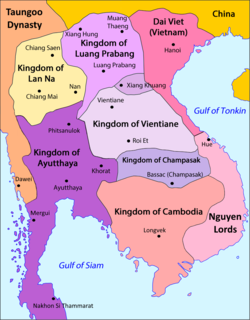
Back مملكة شامباساك Arabic Regne de Champasak Catalan Königreich Champasak German Reĝlando Ĉampasako Esperanto Champasak (reino) Spanish Champasakeko Erresuma Basque Champassakin kuningaskunta Finnish Royaume de Champassak French Kerajaan Champasak ID Regno di Champasak Italian
This article has multiple issues. Please help improve it or discuss these issues on the talk page. (Learn how and when to remove these messages)
|
Kingdom of Champasak ອານາຈັກຈຳປາສັກ (Lao) Anachak Champasak | |||||||||
|---|---|---|---|---|---|---|---|---|---|
| 1713–1904 | |||||||||
|
Flag | |||||||||
 The Kingdom of Champasak and its neighbors in the 18th century | |||||||||
| Status | Independent (1713-1778) Vassal of Siam (1778–1904) | ||||||||
| Capital | Champasak | ||||||||
| Common languages | Lao | ||||||||
| Religion | Theravada Buddhism | ||||||||
| Government | Absolute monarchy | ||||||||
| King | |||||||||
• 1713–1737 | Nokasad (first) | ||||||||
• 1900–1904 | Ratsadanay (last) | ||||||||
| History | |||||||||
• Dissolution of Lan Xang | 1713 | ||||||||
• Vassal of Siam | 1778 | ||||||||
• Annexed to French Laos | 1904 | ||||||||
| Currency | Lat, Hoi, Phot Duang | ||||||||
| |||||||||
| Today part of | Laos Thailand Cambodia Vietnam | ||||||||
| History of Laos | ||||||||||||||
|---|---|---|---|---|---|---|---|---|---|---|---|---|---|---|
 | ||||||||||||||
| Muang city-states era | ||||||||||||||
|
||||||||||||||
| Lan Xang era | ||||||||||||||
|
||||||||||||||
| Regional kingdoms era | ||||||||||||||
|
||||||||||||||
| Colonial era | ||||||||||||||
|
||||||||||||||
| Independent era | ||||||||||||||
|
||||||||||||||
| See also | ||||||||||||||
The Kingdom of Champasak (Lao: ຈຳປາສັກ [tɕàmpàːsák]) or Bassac, (1713–1904) was a Lao kingdom under Nokasad, a grandson of King Sourigna Vongsa, the last king of Lan Xang and son-in-law of the Cambodian King Chey Chettha IV.[citation needed] Bassac and the neighboring principalities of Attapeu and Stung Treng emerged as power centers under what was later to be described as the Mandala Southeast Asian political model.[1]
The kingdom was sited on the eastern or Left Bank of the Mekong, south of the Right Bank principality of Khong Chiam where the Mun River joins; and east of where the Mekong makes a sharp bend to the west to return abruptly and flow southeasterly down to what is now Cambodia.[citation needed]
- ^ Murdoch, John B. (1974). "The 1901-1902 Holy Man's Rebellion" (PDF). Journal of the Siam Society. JSS Vol.62.1 (digital image). Siam Heritage Trust: 2–9. Archived from the original (free) on July 13, 2018. Retrieved April 2, 2013.
Furthest afield were Vientiane and Bassac....
